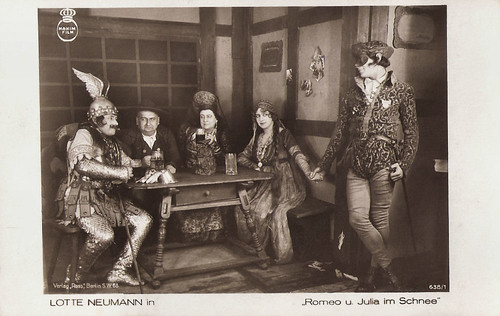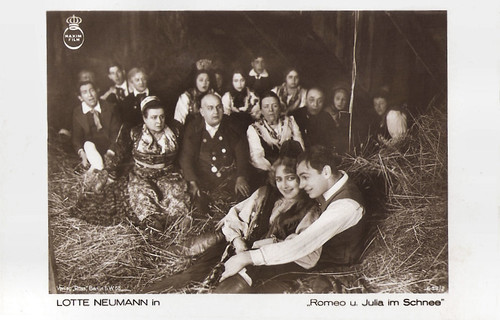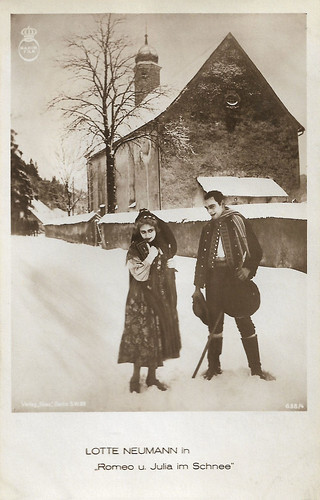After his smash hit Kohlhiesel's Töchter/Kohlhiesel's Daughters (1920), Ernst Lubitsch made another comical variation on a Shakespeare play, Romeo und Julia im Schnee/Romeo and Juliet in the Snow (1920). This comedy is set in the 19th century in the small village Schwabstedt in the Schwarzwald (Black Forest) where two farmers families are feuding. Romeo is played by unknown Gustav von Wangenheim and Julia by star Lotte Neumann. This was Lubitsch’s last short comedy.

German postcard. Ross Verlag, No. 636/1. Lotte Neumann in the Ernst Lubitsch comedy Romeo und Julia im Schnee (Romeo and Juliet in the Snow, 1920), a Maxim Film production. The man on the left dressed as antique hero could be Julius Falkenstein as Paris. The others are from left to right Jakob Tiedtke (Herr Capulethofer), Marga Köhler (his wife), Lotte Neumann (Julia) and Gustav von Wangenheim (Romeo Montekugerl).

German postcard. Ross Verlag, no. 638/2. Photo: Maxim Film. Publicity still for Romeo und Julia im Schnee/Romeo and Juliet in the Snow (Ernst Lubitsch, 1920), with Lotte Neumann (Julia) and Gustav von Wangenheim (Romeo Montekugerl).
With Romeo und Julia im Schnee/Romeo and Juliet in the Snow (1920), Ernst Lubitsch 'deconstructs' Shakespeare's Romeo and Juliet into an amsusing farce, set in a a wintry Tyrolean village. The script was written by Lubitsch with Hanns Kräly. The two would go on to work together for a long time, and for Kräly, this collaboration would later in his career result in an Oscar.
In Kräly's script, Romeo and Juliet love each other but they can't marry because their families, the Capulethofer and the Montekugerl, are feuding. They are enemies since Mr. Capulethofer (Jakob Tiedtke) and Mr. Montekugerl (Ernst Rückert) wanted to bribe the village judge during a process with a sausage and therefore both were sentenced to pay the process costs.
Julia (Lotte Neumann) is supposed to marry the young Paris (Julius Falkenstein), but at first she falls in love with Romeo (Gustav von Wangenheim), the son of the house Montekugerl, who has returned to the village after a year of military service. A mask festival is scheduled, on which Paris wants to court Julia. Romeo, however, manages to make him drunk and to slip into his costume.
Romeo and Juliet decide to marry the same night. Julia, however, should now be betrothed against her will with Paris and Juliet’s father even threatens to cut off Julia’s hair. Faced with their parents opposition to their match, the desperate lovers decide to poison themselves. But unlike in the Shakespeare play, Lubitsch and Kräly serve us a happy ending.
The apothecary gives the loving couple sugar-water instead of poison. They don't die, of course, but Julia has left a farewell letter to her family, and the excitement is great. Convinced their children are dead, the two families admit their faults. The happy lovers leap up and say "Surprise!" And everybody else falls down on an icy patch.
All the characters Romeo und Julia im Schnee/Romeo and Juliet in the Snow are played for comic effect, especially the ridiculous feuding fathers, and many snowballs are hurled in the film. Shooting took place in the Black Forest and also in the Maxim Studios on Blücherstraße in Berlin.
The world premiere of of the film was on 12 March 1920 in the Mozartsaal and in the U.T. Kurfürstendamm in Berlin. This was three days after the release of Lubitsch's other Shakespeare adaptation Kohlhiesel's Töchter/Kohlhiesel's Daughters (1920). That comedy would become the bigger success of the two films, but nowadays reviewers like the Romeo and Julia parody as well.
At IMDb, P. Steier reviews: "A bright comedy. Plenty of low humor. Nice sets and costumes. The best costumes were for scenes at a costume ball."
Another IMDb reviewer, Netwallah adds: "The costume ball is particularly fun to watch, with cousin Tübalder in armor and an absurd winged helmet, and the authorized suitor in a yellow curly wig and angel wings. Better still are the five or six costumes involving enormous papier-maché heads."

German postcard by Ross Verlag, no. 638/3. Photo: Maxim Film. Publicity still for Romeo und Julia im Schnee/Romeo and Juliet in the Snow (Ernst Lubitsch, 1920), with Lotte Neumann (Julia) and Gustav von Wangenheim (Romeo Montekugerl).

German postcard. Ross Verlag, no. 636/4. Photo: Maxim Film. Publicity still for Romeo und Julia im Schnee/Romeo and Juliet in the Snow (Ernst Lubitsch, 1920), with Lotte Neumann (Julia) and Gustav von Wangenheim (Romeo Montekugerl).
Sources: Thomas Elsaesser (Weimar Cinema and After: Germany's Historical Imaginary), P. Steier (IMDb), Netwallah (IMDb), B.U.F.V.C., Wikipedia (German) and IMDb.

German postcard. Ross Verlag, No. 636/1. Lotte Neumann in the Ernst Lubitsch comedy Romeo und Julia im Schnee (Romeo and Juliet in the Snow, 1920), a Maxim Film production. The man on the left dressed as antique hero could be Julius Falkenstein as Paris. The others are from left to right Jakob Tiedtke (Herr Capulethofer), Marga Köhler (his wife), Lotte Neumann (Julia) and Gustav von Wangenheim (Romeo Montekugerl).

German postcard. Ross Verlag, no. 638/2. Photo: Maxim Film. Publicity still for Romeo und Julia im Schnee/Romeo and Juliet in the Snow (Ernst Lubitsch, 1920), with Lotte Neumann (Julia) and Gustav von Wangenheim (Romeo Montekugerl).
Sugar-water and snowballs
With Romeo und Julia im Schnee/Romeo and Juliet in the Snow (1920), Ernst Lubitsch 'deconstructs' Shakespeare's Romeo and Juliet into an amsusing farce, set in a a wintry Tyrolean village. The script was written by Lubitsch with Hanns Kräly. The two would go on to work together for a long time, and for Kräly, this collaboration would later in his career result in an Oscar.
In Kräly's script, Romeo and Juliet love each other but they can't marry because their families, the Capulethofer and the Montekugerl, are feuding. They are enemies since Mr. Capulethofer (Jakob Tiedtke) and Mr. Montekugerl (Ernst Rückert) wanted to bribe the village judge during a process with a sausage and therefore both were sentenced to pay the process costs.
Julia (Lotte Neumann) is supposed to marry the young Paris (Julius Falkenstein), but at first she falls in love with Romeo (Gustav von Wangenheim), the son of the house Montekugerl, who has returned to the village after a year of military service. A mask festival is scheduled, on which Paris wants to court Julia. Romeo, however, manages to make him drunk and to slip into his costume.
Romeo and Juliet decide to marry the same night. Julia, however, should now be betrothed against her will with Paris and Juliet’s father even threatens to cut off Julia’s hair. Faced with their parents opposition to their match, the desperate lovers decide to poison themselves. But unlike in the Shakespeare play, Lubitsch and Kräly serve us a happy ending.
The apothecary gives the loving couple sugar-water instead of poison. They don't die, of course, but Julia has left a farewell letter to her family, and the excitement is great. Convinced their children are dead, the two families admit their faults. The happy lovers leap up and say "Surprise!" And everybody else falls down on an icy patch.
All the characters Romeo und Julia im Schnee/Romeo and Juliet in the Snow are played for comic effect, especially the ridiculous feuding fathers, and many snowballs are hurled in the film. Shooting took place in the Black Forest and also in the Maxim Studios on Blücherstraße in Berlin.
The world premiere of of the film was on 12 March 1920 in the Mozartsaal and in the U.T. Kurfürstendamm in Berlin. This was three days after the release of Lubitsch's other Shakespeare adaptation Kohlhiesel's Töchter/Kohlhiesel's Daughters (1920). That comedy would become the bigger success of the two films, but nowadays reviewers like the Romeo and Julia parody as well.
At IMDb, P. Steier reviews: "A bright comedy. Plenty of low humor. Nice sets and costumes. The best costumes were for scenes at a costume ball."
Another IMDb reviewer, Netwallah adds: "The costume ball is particularly fun to watch, with cousin Tübalder in armor and an absurd winged helmet, and the authorized suitor in a yellow curly wig and angel wings. Better still are the five or six costumes involving enormous papier-maché heads."

German postcard by Ross Verlag, no. 638/3. Photo: Maxim Film. Publicity still for Romeo und Julia im Schnee/Romeo and Juliet in the Snow (Ernst Lubitsch, 1920), with Lotte Neumann (Julia) and Gustav von Wangenheim (Romeo Montekugerl).

German postcard. Ross Verlag, no. 636/4. Photo: Maxim Film. Publicity still for Romeo und Julia im Schnee/Romeo and Juliet in the Snow (Ernst Lubitsch, 1920), with Lotte Neumann (Julia) and Gustav von Wangenheim (Romeo Montekugerl).
Sources: Thomas Elsaesser (Weimar Cinema and After: Germany's Historical Imaginary), P. Steier (IMDb), Netwallah (IMDb), B.U.F.V.C., Wikipedia (German) and IMDb.
No comments:
Post a Comment